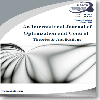Parameter effect analysis of particle swarm optimization algorithm in PID controller design
Parameter effect analysis of particle swarm optimization algorithm in PID controller design
___
- Krohling, R. A., & Rey, J. P. (2001). Design of optimal disturbance rejection pid controllers using genetic algorithms. IEEE Transactions on Evolutionary Computation, 5(1), 78–82. .
- Wang, P., & Kwok, D. (1994). Optimal design of pid process controllers based on genetic al- gorithms. Control Engineering Practice, 2(4), 641–648.
- Chiha, I., Liouane, N., & Borne, P. (2012). Tuning pid controller using multiobjective ant colony optimization. Applied Computational Intelligence and Soft Computing, 2012, 11.
- Ayas, M. S., Altas, I. H., & Sahin, E. (2018). Fractional order based trajectory tracking control of an ankle rehabilitation robot. Transactions of the Institute of Measurement and Control, 40(2), 550–564.
- Sahin, E., & Altas, I. H. (2018). Optimized fractional order control of a cascaded syn- chronous buck–boost converter for a wave-uc hybrid energy system. Electrical Engineering, 100(2), 653–665.
- Altinoz, O. T., (2018). Multiobjective PID controller design for active suspension sys- tem: scalarization approach. An Interna- tional Journal of Optimization and Control:Theories & Applications (IJOCTA), 8(2), 183–194.
- Erguzel, T. T., (2015). A hybrid PSO-PID ap- proach for trajectory tracking application of a liquid level control process. An International Journal of Optimization and Control: Theo- ries & Applications (IJOCTA), 5(2), 63–73.
- Rajasekhar, A., Jatoth, R. K., & Abraham, A. (2014). Design of intelligent pid/piλdμ speed controller for chopper fed dc motor drive using opposition based artificial bee colony algorithm. Engineering Applications of Artificial Intelligence, 29, 13–32.
- Gaing, Z.-L. (2004). A particle swarm opti- mization approach for optimum design of pid controller in avr system. IEEE transactions on energy conversion, 19(2), 384–391.
- Zamani, M., Karimi-Ghartemani, M., Sadati, N., & Parniani, M. (2009). Design of a frac- tional order pid controller for an avr using particle swarm optimization. Control Engi- neering Practice, 17(12), 1380–1387.
- Solihin, M. I., Tack, L. F., & Kean, M. L. (2011). Tuning of pid controller using particle swarm optimization (pso). International Jour- nal on Advanced Science, Engineering and In- formation Technology, 1(4), 458–461.
- Basu, A., Mohanty, S., & Sharma, R. (2016). Designing of the pid and fopid controllers us- ing conventional tuning techniques. Interna- tional Conference on Inventive Computation Technologies (ICICT), 2, 1–6.
- Ang, K. H., Chong, G., & Li, Y. (2005). Pid control system analysis, design, and tech- nology. IEEE transactions on control systems technology, 13(4), 559–576.
- Ziegler, J. G. & Nichols, N. B. (1942). Opti- mum settings for automatic controllers.trans. ASME, 64(11).
- Hägglund, T. & Åström, K. J. (2002). Re- visiting the ziegler-nichols tuning rules for pi control. Asian Journal of Control, 4(4), 364– 380.
- Zhang, Y., Wang, S., & Ji, G. (2015). A comprehensive survey on particle swarm optimization algorithm and its applications. Mathematical Problems in Engineering, 2015, 1–39.
- Zhao, J., Li, T., & Qian, J. (2005). Appli- cation of particle swarm optimization algo- rithm on robust pid controller tuning. Inter- national Conference on Natural Computation, Springer, 948–957.
- Idir, A., Kidouche, M., Bensafia, Y., Khet- tab, & Tadjer, K., S. (2018). Speed control of DC motor using PID and FOPID controllers based on differential evolution and PSO. In- ternational Journal of Intelligent Engineering and Systems, 11(4), 241–249.
- Pano, V. & Ouyang, P. R. (2014). Compar- ative study of ga, pso, and de for tuning position domain pid controller. 2014 IEEE International Conference on Robotics and Biomimetics (ROBIO), 1254–1259.
- Sun, L., Li, D., Zhong, Q.-C., & Lee, K. Y. (2016). Control of a class of industrial pro- cesses with time delay based on a modi- fied uncertainty and disturbance estimator. IEEE Transactions on Industrial Electronics, 63(11), 7018–7028.
- Kennedy, J. & Eberhart, R. (1995). Pso opti- mization. Proc. IEEE Int. Conf. Neural Net- works, 4, 1941–1948.
- Nagrath, I. (2006). Control systems engineer- ing. New Age International.
- Schultz, W. & Rideout, V. (1961). Control system performance measures: Past, present, and future. IRE Transactions on Automatic Control, 1, 22–35.
- Shi, Y. & Eberhart, R. C.. (1998), Parame- ter selection in particle swarm optimization. International conference on evolutionary pro- gramming, Springer, 591–600.
- Mallipeddi, R. & Suganthan, P. N. (2008). Empirical study on the effect of population size on differential evolution algorithm. IEEE World Congress on Computational Intelli- gence Evolutionary, 3663–3670.
- Piszcz, A. & Soule, T. (2006). Genetic pro- gramming: Optimal population sizes for vary- ing complexity problems. Proceedings of the 8th annual conference on Genetic and evolu- tionary computation, 953–954.
- Koumousis, V. K. & Katsaras, C. P. (2006). A saw-tooth genetic algorithm combining the effects of variable population size and reini- tialization to enhance performance. IEEE Transactions on Evolutionary Computation, 10(1), 19–28.
- ISSN: 2146-0957
- Yayın Aralığı: 4
- Yayıncı: Prof. Dr. Ramazan YAMAN
A genetic algorithm for fuzzy order acceptance and scheduling problem
Esra KARAKAŞ, Hakan ÖZPALAMUTÇU
Some integral inequalities for multiplicatively geometrically P -functions
Parameter effect analysis of particle swarm optimization algorithm in PID controller design
Mustafa Şinasi AYAS, Erdinç ŞAHİN
Optimization of medical waste routing problem: The case of TRB1 region in Turkey
Analyzing occupational risks of pharmaceutical industry under uncertainty using a Bow-Tie analysis
Analytical studies on waves in nonlinear transmission line media
Control and application of accuracy positioning estimation based real-time location system
